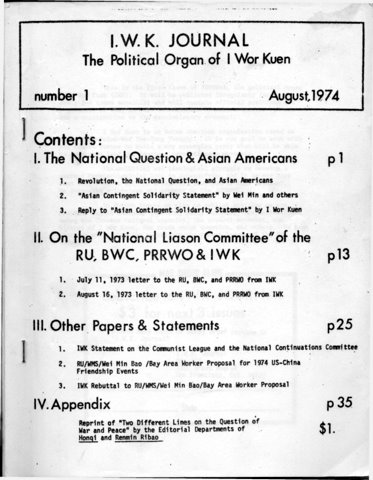
First Published: IWK Journal, No. 1, August 1974.
Transcription, Editing and Markup: Paul Saba
Copyright: This work is in the Public Domain under the Creative Commons Common Deed. You can freely copy, distribute and display this work; as well as make derivative and commercial works. Please credit the Encyclopedia of Anti-Revisionism On-Line as your source, include the url to this work, and note any of the transcribers, editors & proofreaders above.
EROL Note: This document was written in response to a Statement prepared and circulated by Wei Min She and others to mobilize support in the San Francisco Asian community for May Day rally in 1974 called by the Revolutionary Union. In it, IWK explains why it decided not to endorse the Statement.
* * *
In the interest of building principled unity within the Asian Movement around the question of the role Asian workers play within the overall working class, we would like to offer some comments and criticisms of the “Asian Contingent Solidarity Statement.”
In general, we feel that the statement takes an incorrect approach to the question of how to build unity in the working class. The statement takes a subjective and almost apologetic or defensive view to the question of why there is disunity in the class and therefore doesn’t provide a clear and scientific way to analyze how real unity can be built.
To begin with, the statement defines the “American workers’ movement” too mechanically and narrowly. Asian workers are a part of the working class and as such have contributed in many ways to the overall development of the American workers’ movement. Their contributions can be seen in historical examples of Asians struggling against exploitation on the job and the leading role Asian workers have played in fighting national oppression in the Asian communities.
The American workers’ movement is much more than just the officially organized segment of the workers’ movement – by the narrow definition, the majority of Third World and women workers have simply been “out of it” for the past hundred years. The American workers’ movement is also more than just those particular struggles in which workers of all races took part together. The strikes of Chinese garment workers, Japanese farmers, etc. are also part of the American workers’ movement which has dealt blows against the capitalist system. Trade union leadership and political organizations such as the CP-USA and PL have not paid enough attention to the national question and to organizing Third World people on the basis of equality – we should not accept their narrow and chauvinist definition of the workers’ movement.
Secondly, the statement asserts that disunity among the class is caused by “lies handed down by capitalists to confuse and divide the American people.” We feel that it is much more than lies or trickery that has divided the class for all these years. There is a definite material basis for the divisions in the class – i.e. the systematic buying off of a section of white workers. Asian and other Third World workers are found in the lowest paying jobs, in non-unionized industries, have the hardest time being promoted, live in ghetto communities, etc.
Thirdly, we definitely agree that workers of all races “have more in common than differences.” Only through a united working class can Asian and all other workers achieve emancipation. The question is, how can real unity be best achieved? First, we must have a historical and material analysis of why divisions exist in the working class. Second, we must vigorously struggle against and expose trade union misleadership and the leadership of those political organisations which try to gloss over the question of disunity within the class and therefore perpetuate white chauvinism and divisions among the workers. Third, we must recognize the absolute right and primary necessity to organize, activate and raise the political consciousness of Asian and other Third World workers.
The statement implies that whenever Asians organized on their own, it is to be regretted or apologized for. Organizing along national lines on the one hand can be divisive and a bad thing if the struggle is led by narrow nationalists, but on the other hand, can be and is a progressive thing which activates and raises the consciousness of masses of Asians, when the struggle is led by class conscious Marxist-Leninists. Such struggles can be the basis for real unity among the class based on equality.
In summary, the statement doesn’t help to clarify the role of Asian workers within the workers’ movement but rather tends to reinforce narrow, chauvinist and opportunist ideas which have strengthened divisions in the class for many years. Although the solution to the national question and true emancipation for all oppressed and exploited people will not come about until the victory of socialism, we feel that the basis of unity on the national question must be clarified and struggled out in order to go forward in this period of time.